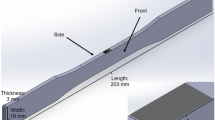Abstract
Nanoindentation load-displacement curves provide a “mechanical fingerprint” of a materials response to contact deformation. Over the last few years, much attention has been focused on understanding the factors controlling the detailed shape of unloading curves so that parameters such as true contact area, Young's modulus, and an indentation hardness number can be derived. When the unloading curve is well behaved (by which we mean approximating to linear behavior, or alternatively, fitting a power-law relationship), then this approach can be very successful. However, when the test volume displays considerable elastic recovery as the load is removed [e.g., for many stiff hard materials and many inhomogeneous systems (e.g., those employing thin hard coatings)], then the unloading curve fits no existing model particularly well. This results in considerable difficulty in obtaining valid mechanical property data for these types of materials. An alternative approach, described here, is to attempt to understand the shapes of nanoindentation loading curve and thus quantitatively model the relationship between Young's modulus, indentation hardness, indenter geometry, and the resultant maximum displacement for a given load. This paper describes the development and refinement of a previous approach by Loubet et al1 originally suggested for a Vickers indenter, but applied here to understand the factors that control the shape of the loading curve during nanoindentation experiments with a pointed, trigonal (Berkovich) indenter. For a range of materials, the relationship P = Kmδ2 was found to describe the indenter displacement, δ, in terms of the applied load P. For each material, Km can be predicted from the Young's modulus (E) and the hardness (H). The result is that if either E or H is known, then the other may be calculated from the experimental loading curve. This approach provides an attractive alternative to finite element modeling and is a tractable approach for those cases where analysis of unloading curves is infeasible.
Similar content being viewed by others
References
J. L. Loubet, J.M. Georges, and J. Meille, in Microindentation Techniques in Materials Science and Engineering, edited by P. J. Blau and B. R. Lawn (American Society for Testing and Materials, Philadelphia, 1986), pp. 72–89.
T. F. Page and S.V. Hainsworth, Surf. Coatings Technol. 68/69, 571–575 (1994).
M. R. McGurk, H. W. Chandler, P. C. Twigg, and T. F. Page, Surf. Coatings Technol. 68/69, 576–581 (1994).
M. F. Doerner and W. D. Nix, J. Mater. Res. 1, 601–609 (1986).
W. C. Oliver and G. M. Pharr, J. Mater. Res. 7, 1564–1583 (1992).
G. M. Pharr, T. Y. Tsui, A. Bolshakov, and W. C. Oliver, in Materials Reliability in Microelectronics IV, edited by P. Børgesen, J. C. Coburn, J. E. Sanchez, Jr., and K. P. Rodbell, and W. F. Filter (Mater. Res. Soc. Symp. Proc. 338, Pittsburgh, PA, 1994), pp. 127–134.
M. V. Swain and J. Menčík, Thin Solid Films 253, 204–211 (1994).
S. V. Hainsworth, A. J. Whitehead, and T. F. Page, in Plastic Deformation of Ceramics, edited by R. C. Bradt, C. A. Brookes, and J.L. Routbort, Proc. Int. Conf. Snowbird, Utah, August 7–12, 1994 (Plenum Publ. Corp., New York, 1995), pp. 173–184.
T. F. Page, W. C. Oliver, and C. J. McHargue, J. Mater. Res. 7, 450–472 (1992).
S. V. Hainsworth and T. F. Page, J. Mater. Sci. 29, 5529–5540 (1994).
P. M. Sargent and T. F. Page, Proc. Brit. Ceram. Soc. 26, 209–224 (1978).
S. J. Bull, T. F. Page, and E. H. Yoffe, Phil. Mag. Lett. 59, 281–288 (1989).
S. V. Hainsworth, H. W. Chandler, and T. F. Page, unpublished.
S. V. Hainsworth, and T. F. Page, in Thin films: Stresses and Mechanical Properties VI, edited by W. W. Gerberich, J-E. Sundgren, H. Gao, and S. P. Baker (Mater. Res. Soc. Symp. Proc. 1996), in press.
J. A. Greenwood and J.B. P. Williamson, Proc. Roy. Soc. London A295, 300–319 (1966).
H. Sjöström, L. Hultman, J-E. Sundgren, S. V. Hainsworth, T. F. Page, and G. S. A. M. Theunissen, J. Vac. Sci. Technol. in J Vac Sci Technol. A. 14, 1–7 (1996).
J. S. Field and M. V. Swain, J. Mater. Res. 8, 297–306 (1993).
Author information
Authors and Affiliations
Rights and permissions
About this article
Cite this article
Hainsworth, S.V., Chandler, H.W. & Page, T.F. Analysis of nanoindentation load-displacement loading curves. Journal of Materials Research 11, 1987–1995 (1996). https://doi.org/10.1557/JMR.1996.0250
Received:
Accepted:
Published:
Issue Date:
DOI: https://doi.org/10.1557/JMR.1996.0250




